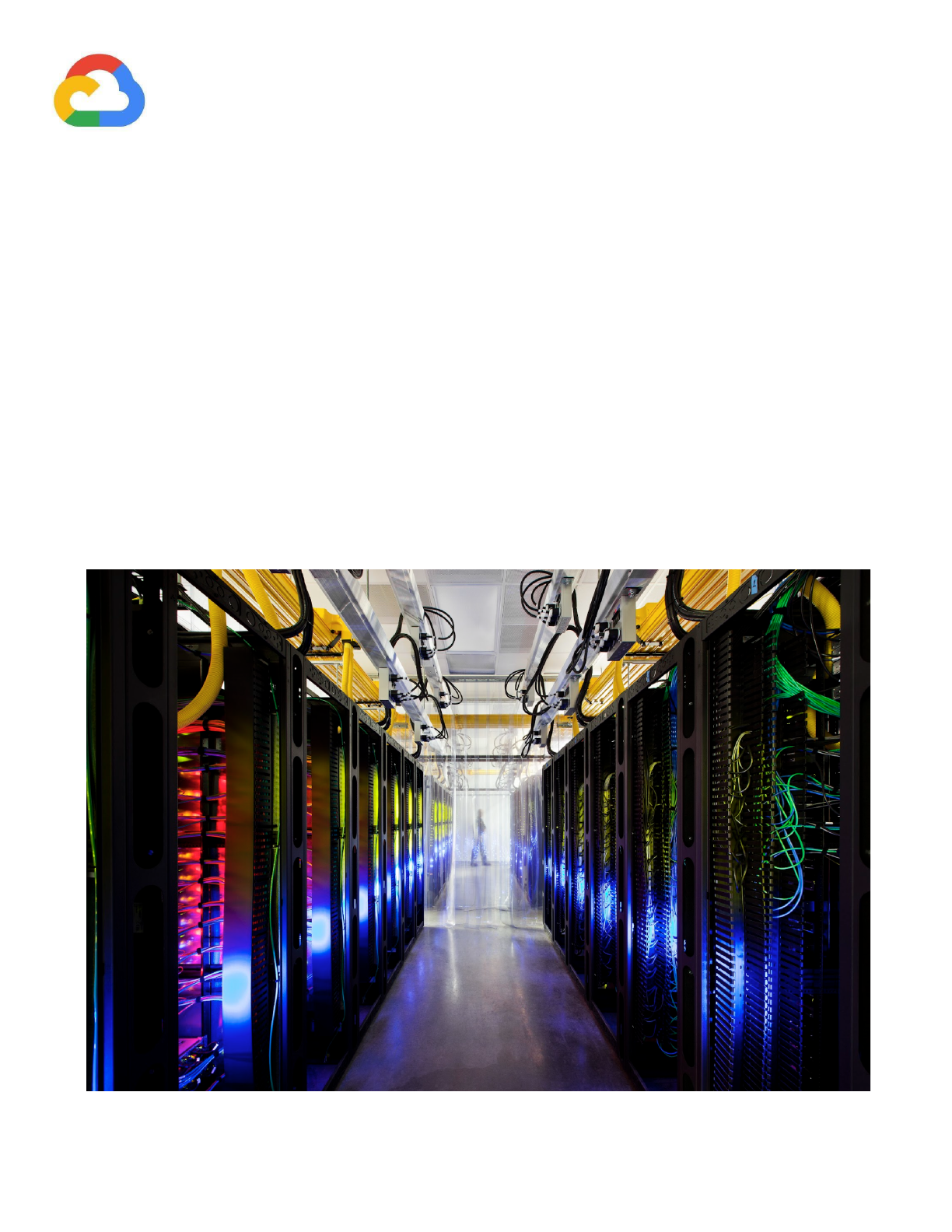
Google Workspace Whitepaper
January 2023
Trusting your data with
Google Workspace

2
Table of Contents
1. Introduction 3
2. Managing your data on Google Workspace 4
2.1 Data Protection 4
2.2 Data Deletion 5
2.3 Data export and download 5
2.4 Data governance 5
2.5 Data residency 7
2.6 Incident detection & response 7
2.7 Interoperability and Portability 8
3. Safeguarding access to your data 8
3.1 Data access controls 8
3.2 Data access transparency 9
3.3 Google employee access authorization 10
3.4 Organizational safeguards 10
3.4.1 Transparency 10
3.4.2 Use of subprocessors 11
3.4.3 Government requests for data 11
4. Security and compliance standards 12
4.1 Independent verification of our control framework 12
4.2 Compliance support for customers 13
5. Conclusion 13
Disclaimer
This whitepaper applies to Google Workspace products described as “Core Services” at Google
Workspace Services Summary. The content contained herein is correct as of January 2023 and
represents the status quo as of the time it was written. Google's security policies and systems may
change going forward, as we continually improve protection for our customers.

3
1. Introduction
At Google Cloud, we’ve set a high bar for what it means to host, serve, and protect our customers' data.
Security and data protection are at the core values of how we design and build our products. We start
from the fundamental premise that Google Cloud customers own their data and control how it is used.
The customer data stored and managed on Google Workspace is processed per your instructions in
accordance with the Data Processing Amendment (DPA) and for no other purpose. Not for advertising,
not for anything else. Our Google Cloud Trust Principles summarize our commitment to protecting the
privacy of data stored by customers in Google Workspace.
This whitepaper details how we provide customers with transparency and control over their data in
Google Workspace. Google Workspace offers built-in data protection at scale, by default, designed to
protect your business from intrusions, theft, and attacks. In addition to continuous security monitoring
for external threats, we explain the robust controls and auditing in place to protect against insider
access to customer data. These include providing customers with near real-time logs of Google
administrator access data, via Access Transparency logs.. If you'd like to learn more about how we
define customer data, please refer to our Google Workspace Terms.
Google Workspace products regularly undergo independent, third-party audits and certifications to
verify that our data protection practices match our controls and commitments. An overview of our key
compliance reports and certifications, as well as how we support our customers with their compliance
journey is also provided in this paper. Lastly, Google participates in such declarations as the EU Cloud
Code of Conduct to further evidence to our customers our commitments to accountability, compliance
support, and robust data protection principles.
While this whitepaper provides information on the tools and resources offered by Google Cloud, please
note that, as a provider of cloud services, we are not in a position to provide our customers with legal
advice - this is something only legal counsel can provide.
2. Managing your data on Google Workspace
This section describes the data lifecycle in Google Workspace through the lens of security and privacy.
2.1 Data Protection
Using Google Workspace services involves transferring data between your computer (typically via your
browser) or mobile device, Google’s servers, and, sometimes, other users. Google enables encryption in
transit by default between your device and our data centers, and uses Transport Layer Security (TLS)
protocol to encrypt requests before transmission outside Google. This helps prevent third parties from
exploiting vulnerabilities in internet connections to access sensitive data.
Google Workspace also applies encryption by default when content is stored at rest – stored on a disk
(including solid-state drives) or backup media. We use an Advanced Encryption Standard (AES) cipher
with a unique 128-bit or stronger key for each chunk of Google Workspace data stored on a local disk.

4
Each chunk key is then encrypted by another 128-bit or stronger key that is managed by a Google-wide
key management service (KMS). Google Workspace data is also encrypted when stored on backup
media, each of which is protected with a 256-bit secret key that itself is encrypted via KMS. For further
information on encryption, please see our Google Workspace Encryption whitepaper.
Customers can control access to data and services on Google Workspace to help ensure that data is
protected in accordance with the organization’s desired configuration. Role-based access controls
enable customers to appoint users as administrators, granting the user the ability to access and
perform certain tasks in the Google Workspace Admin console. You can make a user a super
administrator who can perform all tasks in the Admin console. Or you can assign a role that limits the
administrator’s tasks, for example, by allowing them only to create groups, manage service settings, or
reset a user's password. You can also review our data protection implementation guide for Workspace
and Workspace for Education for additional resources.
Customers can strengthen account security by using 2-step verification and security keys. These can
help mitigate risks such as the misconfiguration of employee access controls or attackers taking
advantage of compromised accounts. With the Advanced Protection Program for enterprise, we can
enforce a curated set of strong account security policies for enrolled users. These include requiring
security keys, blocking access to untrusted apps, and enhanced scanning for email threats.
To facilitate easier user access, while at the same time protecting the security of data, Google has
developed BeyondCorp Enterprise. This provides granular controls for Google Workspace apps, based
on a user’s identity and context of the request (such as device security status or IP address). Based on
the BeyondCorp security model developed by Google, users can access web applications and
infrastructure resources from virtually any device, anywhere, without utilizing remote-access VPN
gateways while administrators can establish controls over the device.
Protecting information on mobile and desktop devices can be a key concern for customers. Google
Workspace customers can use endpoint management to help protect corporate data on users’ personal
devices and on an organization’s company-owned devices. By enrolling the devices for management,
users get secure access to Google Workspace services, and organizations can set policies to keep
devices and data safe through device encryption and screen lock or password enforcement.
Furthermore, if a device is lost or stolen, corporate accounts can be remotely wiped from mobile
devices and users can be remotely signed out from desktop devices. Reports enable customers to
monitor policy compliance and get information about users and devices. We discuss endpoint
management further in our managing devices for your organization documentation.
2.2 Data Deletion
Customers may also seek control over the deletion of data. The safe deletion of data is important to
protect against the risk of accidental data loss. At the same time, when customers instruct deletion of
data, it is equally important that this data be deleted completely from servers after a period of time.
When you delete data in Google Workspace, we immediately start the process of removing it from the
product and our systems unless it is subject to a Google Vault retention policy per the customer’s

5
instructions. Immediately, we aim to remove it from view. We then begin a process designed to safely
and completely delete the data from our storage systems. Each Google storage system from which
data gets deleted has its own detailed process for safe and complete deletion. This might involve
repeated passes through the system to confirm all data has been deleted. Our services also use
encrypted backup storage as another layer of protection to help recover from potential disasters. Data
can remain on these systems for up to six months.
2.3 Data expo and download
Customers may want to export and download their data securely from our services. We provide
portability and migration capabilities and our specific data portability commitments are included in our
data processing agreement.
The data export tool available in your Google Workspace Admin console enables you to export all
supported data for each active user in your organization. We also provide the ability for your users to
directly download their data on an individual level.
2.4 Data governance
Enterprises operating in certain countries or regulated industries, such as Healthcare and Financial
Services, may be required to meet certain compliance obligations, e.g., HIPAA, PCI DSS, and GDPR. By
using security settings in Google Workspace and leveraging the compliance certifications Google
Workspace has achieved, customers can manage their compliance. Section 4.2 of this paper provides
an overview of the compliance support we offer customers.
Most organizations also have internal policies which dictate the handling of sensitive data. To help
Google Workspace administrators maintain control over sensitive data, we offer information rights
management in Google Drive. Administrators and users can use the access permissions in Google
Drive to protect sensitive content by preventing the re-sharing, downloading, printing, or copying of the
file or changing of permissions. Administrators can control how users in their organization share
Google Drive files and folders. For example, whether users can share files with people outside of their
organization or whether sharing is restricted to only trusted domains. Optional alerts can be
established to remind users to check that files aren't confidential before they are shared outside of the
organization.
Many organizations are required to preserve data for certain periods of time and to delete sensitive
data after a time period. Google Vault, the retention solution for Google Workspace customers, can be
used to set retention rules that control how long specific types of data are retained. When retention
coverage ends, Vault immediately begins to remove affected data. Customers can create as many
custom rules as their organization needs. Learn more about how Vault manages retention.
Data loss prevention (DLP) adds another layer of protection designed to prevent sensitive or private
information such as payment card numbers, national identification numbers, or protected health
information, from leaking outside of an organization. DLP enables customers to audit how sensitive
data is flowing in their enterprise and turn on warning or blocking actions to prevent users from either
accidentally or maliciously sending confidential data. To enable this, DLP provides over 100 predefined

6
content detectors, including detection of global and regional identifiers, medical information, and
credentials. Customers can also define their own custom detectors to meet their needs. For
attachments and image-based documents, DLP uses Google’s leading optical character recognition to
increase detection coverage and quality. Learn more here about Gmail DLP. DLP can also be used to
prevent users from sharing sensitive content in Google Drive or shared drive with people outside of your
organization.
Enterprises storing data in the Cloud seek visibility into data access and account activity. Google
Workspace audit logs help security teams maintain audit trails in Google Workspace and view detailed
information about Admin activity, data access, and system events. Google Workspace users can use
the Admin Console to access these logs and can customize and export logs as required.
Customers may wish to allow their users access to third-party apps or may even wish to develop their
own custom apps. Google Workspace has a robust developer ecosystem, with thousands of apps
available via Google Workspace Marketplace and directly to customers, and a rich API framework
enabling users to develop custom apps. However, not all third-party apps will conform to every
customer’s security policy. With app access control, enterprises can see which third-party apps users
have approved to access their Google Workspace data and can reduce this risk by limiting access to
trusted apps. We also help enterprises manage risk with app verification, which ensures that apps
accessing Gmail data meet security and privacy standards.
2.5 Data residency
Google’s globally distributed data centers reduce latency for multinational organizations and protect
their data with geo-redundancy. Some organizations, however, have requirements around where their
data is stored, and we’re committed to meeting their needs.
Data regions for Google Workspace provide control over the geographical location for storage of email
messages, documents, and other Google Workspace content. Customers can choose between the
United States, Europe, or global storage. Additionally, data regions offer the flexibility to choose one
data region for some of your users, or different data regions for specific departments or teams.
Additional information is available on the data regions support page.
2.6 Incident detection & response
With multiple security and privacy controls in place, organizations need a centralized location where
they can prevent, detect, and respond to threats.The Google Workspace security center provides
advanced security information and analytics, and added visibility and control into security issues
affecting your domain. It brings together security analytics, actionable insights and best practice
recommendations from Google to empower you to protect your organization, data and users.
As an administrator, you can use the security dashboard to see an overview of different security center
reports. The security health page provides visibility into your Admin console settings to help you better
understand and manage security risks. Furthermore, you can use the security investigation tool to
identify, triage, and take action on security and privacy issues in your domain. Administrators can
automate actions in the investigation tool by creating activity rules to detect and remediate such issues

7
more quickly and efficiently. For example, you can set up a rule to send email notifications to certain
administrators if Drive documents are shared outside the company.
In addition, the alert center for Google Workspace provides all Google Workspace customers with alerts
and actionable security insights about activity in your domain to help protect your organization from the
latest security threats including phishing, malware, suspicious account, and suspicious device activity.
You can also use the alert center API to export alerts into your existing ticketing or SIEM platforms.
Google has a rigorous internal process for managing data incidents. This process specifies actions,
escalations, mitigation, resolution, and notification of any potential incidents impacting the
confidentiality, integrity, or availability of customer data. You can learn more about how Google detects
and manages our own incidents in our Data incident response process whitepaper.
2.7 Interoperability and Poability
Google’s belief in an open cloud stems from our deep commitment to open source. We believe that
open source is the future of public cloud: It’s the foundation of IT infrastructure worldwide and has been
a part of Google’s foundation since day one. This is reflected in our contributions to projects like
Kubernetes, TensorFlow, Go, and many more. We believe customers should use us because they love
us, not because they are locked in.
We are committed to an open cloud that enables our customers to set up the optimal solution,
spanning on-premise and multiple clouds, without being locked into a single provider. We offer tools
that operate across systems and vendors and allow you to monitor your system from a single place.
Google Cloud built Google Workspace with its commitment to open source technology and
interoperability top-of-mind. We know that our customers use Google Workspace for critical
communication and collaboration that keeps businesses running and have built the services within
Google Workspace to ensure that data is not only secure, but also readily portable in the event that they
need to change providers or take data offline.
We have published the Google Cloud Transparency Declaration which demonstrates Google Cloud's
adherence to the SWIPO (Switching Cloud Providers and Porting Data) Data Portability Codes of
Conduct for IaaS and SaaS services. These voluntary Data Portability Codes govern the relationship
between Cloud customers and Cloud Service Providers (CSPs) to ensure customers are able to
effectively migrate their data from one cloud provider to another. Customers can confidently carry out
their work on Google Workspace, knowing that it offers robust data sovereignty capabilities and that we
continue to invest in the development of additional capabilities.
3. Safeguarding access to your data
At Google, protecting the sensitive data that customers and enterprises trust us with is a top priority.
Our zero trust-based architecture and least privilege principles include:
● The industry's strongest authentication protocols
● Is highly resistant to data exfiltration, and,

8
● Deploys 24/7 advanced monitoring and analytics to restrict the misuse of credentials, detect
abnormal employee activity, and automatically respond to new or evolving threats.
3.1 Data access controls
Google Cloud believes that customers should have a robust level of control over data stored in the
cloud.We’ve developed product capabilities that enhance your control over your data and provide
expanded visibility into when and how your data is accessed. Google has three types of controls in
place to ensure that each of these access pathways function as intended:
1. Direct customer access: All authentication sessions to Google Workspace are encrypted and
users can only access the services enabled by their Domain Administrator.
○ Zero trust access model: Google Workspace customers can also use Context-Aware
Access to create granular access control policies to apps based on attributes such as
user, location, device security status, and IP address. Based on the BeyondCorp security
model developed by Google, users can access web applications and infrastructure
resources from virtually any device, anywhere, without utilizing remote-access VPN
gateways while administrators can establish controls over the device. Access decisions
are not based solely on static credentials or whether they originate from a corporate
intranet. The complete context of a request (user identity, location, device ownership and
configuration, and fine-grained access policies) is evaluated to determine its validity and
guard against phishing attempts and credential-stealing malware.
2. Internal Google access by authorized individuals: As part of Google’s long-term commitment to
security and transparency, you can use Access Transparency to review logs of actions for
covered service data taken by Google staff - when accessing certain customer data as
permitted by law. Google implements strict access controls to ensure the person accessing the
data is authorized to do so and validates that a business justification for access is provided. The
justification is made visible to the customer through Access Transparency Logs.
3. Google Workspace Service Access: When internal Google Workspace services access your
data, Google uses technologies like Binary Authorization to validate the provenance and integrity
of the software.
Client-side Encryption
Google Workspace’s unique approach to client-side encryption provides our customers with
authoritative privacy control over their data through encryption keys they can hold on-site, within a
nation’s borders, or within any other boundary they define. Google never has access to the keys or key
holders, which means the data is indecipherable to us, and we have no technical ability to access it. We
deliver this level of encryption without needing legacy desktop clients while maintaining the same
high-quality experience for your users such as online co-authoring.
Organizations can choose to use Client-side encryption pervasively across all their users, or create rules
that apply to specific users, organizational units, or shared drives. Client-side encryption is now
generally available for Google Drive, Docs, Sheets, and Slides.

9
3.2 Data access transparency
Google Cloud is explicit in its commitment to customers: you own your data, and we will never use it for
any purpose other than those necessary to fulfill our contractual obligations. We also know that in
addition to commitments, customers want additional transparency and control from their cloud service
provider.
As part of Google's long-term commitment to transparency and user trust, we provide Access
Transparency, a feature that enables customers to review logs of actions taken by Google staff when
accessing your specific customer data.
Access Transparency log entries include the following types of details: the affected resource and
action; the time of the action; the reasons for the action (for example, the case number associated with
a customer support request); and data about who is acting on the data (such as the Google staff
member's location).
Access Transparency logs are generated when people at Google access data in an Access
Transparency supported service (for example, if a Support engineer accesses your data to fix a
Calendar problem). Google Workspace customers can monitor the logs through the Google Workspace
Admin console.
Learn more about Access Transparency for Google Workspace on this support page.
3.3 Google employee access authorization
Google employees undergo background checks, are required to execute a confidentiality agreement,
and comply with Google’s code of conduct. In addition, we’ve designed our systems to limit the number
of employees that have access to customer data and to actively monitor the activities of those
employees.
Google employees are only granted a limited set of default permissions to access company resources.
Access to internal support tools is controlled via Access Control Lists (ACLs). Google follows a formal
process to grant or revoke employee access to Google resources, and access is automatically removed
for departing employees.
Access authorization is enforced at all relevant layers of the system. Approvals are managed by
workflow tools and logged. An employee's authorization settings are used to control access to all
resources, including data and systems for Google Cloud products. Access is monitored by our
dedicated security teams as a check on the effectiveness of our controls. The security teams actively
monitor access patterns and investigate unusual events.
For further information on employee onboarding and security and privacy training, please refer to our
security whitepaper.

10
3.4 Organizational safeguards
3.4.1 Transparency
At Google Cloud, we believe that trust is created through transparency, and we want to be transparent
about our commitments and what you can expect when it comes to our shared responsibility for
protecting and managing your data in the cloud. We understand that a big part of being transparent is
providing information on when requests are made for access to your data.
In our Transparency Reports, we share our data about how the policies and actions of governments and
corporations affect privacy, security, and access to information.
We also offer Access Transparency for Google Workspace that logs and surfaces the customer
administrative access to customer data by Google Cloud as permitted by law. We also undergo
third-party audits to publicly verify our privacy and security compliance obligations.
3.4.2 Use of subprocessors
Google companies directly conduct the majority of data processing activities required to provide
Google Cloud services. However, we do engage with some carefully selected third-party vendors to
perform limited activities in connection with Google Cloud services.
We recognize the importance of transparency about the third parties we engage with who may process
your data. We share information about our vendors on our Google Workspace and Cloud Identity
Subprocessor page to provide our customers with visibility. This includes who they are, where they are
located, the specific services they support, and the limited processing of customer data they are
authorized to perform.
Google expects our Subprocessors to meet the same high standards that we do. Before onboarding
Subprocessors, Google assesses their security and privacy practices. We do this to ensure that
Subprocessors provide a level of security and privacy appropriate to their data access and the scope of
the activities they are engaged to perform.
Once Google has assessed the risks, the Subprocessor is required to enter into appropriate security,
confidentiality, and privacy contract terms. In particular, Google requires our Subprocessors to only
access and use your data to the extent required to perform the obligations subcontracted to them and
to do so in accordance with our contract with you. Google will remain fully liable for all obligations
subcontracted to our Subprocessors.
To enable you to retain oversight of our Subprocessors, we will notify you when we engage a new
Subprocessor so that you know in advance before any new Subprocessor starts processing your data.

11
3.4.3 Government requests for data
Our Transparency Report discloses, where permitted by the applicable laws, the number of requests
made by law enforcement agencies and government bodies for Enterprise Cloud customer information.
The historical numbers disclosed in our report for Enterprise Cloud Requests for customer information
show that the number of Enterprise Cloud-related requests is extremely low compared to our Enterprise
Cloud customer base.
We also work hard to help give our customers a clear and detailed understanding of our process for
responding to government requests for Cloud customer data in the rare cases where they do happen.
Customers and end users can also review the number of requests Google LLC has received under U.S.
National Security authorities for all Google services (including Google Cloud) in our Transparency
Report.
4. Security and compliance standards
4.1 Independent verication of our control framework
Moving to the cloud means protecting sensitive workloads while achieving and maintaining compliance
with complex regulatory requirements, frameworks, and guidelines. Failure to comply with regulations
in any part of this network can lead to cascading compliance issues throughout the ecosystem.
Google Cloud’s industry-leading security, third-party audits, and certifications help support your
compliance. Our customers and regulators expect independent verification of security, privacy, and
compliance controls. Google undergoes several independent third-party audits on a regular basis to
provide this assurance. Some of the key international standards we are audited against are:
● ISO 27001 (Information Security Management)
● ISO 27017 (Cloud Security)
● ISO 27018 (Cloud Privacy)
● ISO/IEC 27701 (Privacy - Data Processor)
● SOC 2 and SOC 3 reports
● NIST 800-53
● CSA Star
● GxP
Google also participates in sector and country-specific frameworks, such as FedRAMP (US
government), BSI C5 (Germany), MTCS (Singapore), HIPAA (US government), iRAP (Australia), MeitY
(India) and many others. We also provide resource documents and mappings to frameworks and laws
where formal certifications or attestations may not be required or applied.
For a complete listing of our compliance offerings, please visit our compliance resource center.
Furthermore, for years, Google Cloud's industry-leading controls, contractual commitments, and

12
accountability tools have helped organizations across Europe meet stringent data protection regulatory
requirements. This commitment to supporting the compliance efforts of European companies has
earned us the trust of businesses like retailers, manufacturers and financial services providers.
As part of our continued efforts to uphold that trust, Google Cloud was one of the first cloud providers
to support and adopt the EU GDPR Cloud Code of Conduct (CoC). The CoC is a mechanism for cloud
providers to demonstrate how they offer sufficient guarantees to implement appropriate technical and
organizational measures as data processors under the GDPR.
4.2 Compliance suppo for customers
Regulations such as GDPR place significant emphasis on enterprises knowing how their data is being
processed, who has access to data, and security incidents will be managed. Google Cloud has
dedicated teams of engineers and compliance experts who support our customers in meeting their
regulatory compliance and risk management obligations. Our approach includes collaborating with
customers to understand and address their specific regulatory needs. Together with our reports and
certifications, we assist our customers in documenting an integrated controls and governance
framework.
For customers in certain regions or customers operating in certain regulated verticals, we allow
customers to conduct audits to validate Google’s security and compliance controls.
5. Conclusion
Protecting customer data is a primary design consideration for Google Cloud’s infrastructure,
applications, and personnel operations. Google’s security practices are verified by independent
third-parties, providing assurance to customers regarding our security controls and practices. Google
offers strong contractual commitments to ensure our customers maintain control over their data and
its processing, including the commitment that we only process your customer data according to your
instructions.
Google Cloud is designed to meet stringent privacy and security standards based on industry best
practices. Google has strong contractual commitments regarding data ownership, data use, security,
transparency, and accountability. These commitments ensure you maintain control over your data and
how it is processed, including the assurance that your data is not used for advertising or any purpose
other than to deliver Google Cloud services. In addition, we give you the tools you need to help meet
your compliance and reporting requirements.
Furthermore, because protecting data is core to Google Cloud, we can make extensive investments in
security, resources and expertise at a scale that others cannot. Our investment frees you to focus on
your business and innovation. Google’s operations and collaboration with the security research
community also enable us to address vulnerabilities quickly or prevent them entirely.

13
For these reasons and more, organizations across the globe trust Google with their most valuable
asset: their information. Google will continue to invest in Google Workspace to allow you to benefit
from our services in a secure and transparent manner.
